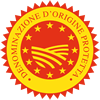Description
The Bleu de Gex Haut-Jura PDO is a cheese obtained from cow's milk of Montbéliarde breed or French Simmental breed. The milk cows must be nurtured with forages coming from pastures situated in the geographic area concerned.
Production Area
The production area of Bleu de Gex Haut-Jura PDO covers the Massif du Jura, in other words the Haut-Jura area in the departments of Ain and Jura in the regions Rhone-Alps and Franche-Comte.
Production Method
The production of Bleu de Gex Haut-Jura PDO is still made using the traditional method. Indeed, just like in the past, the curd is obtained adding rennet from calf abomasums, and then it is cut and brushed. Later, it is put individually into moulds measuring 26 cm of diameter, after being wrapped into jute or linen cloths. All the mentioned operations must be made by hand and the maximum gap of time between milking and the addition of rennet must be of 36 hours. The dry salting is made in individual vats, like in the past, and lasts more days, as it gives the rind and the paste a peculiar consistency. Refinement takes place in fresh and humid cellars for about 21 days; here the moulds are laid on spruce wood boards. The greenish-blue veins of this cheese are obtained thanks to the addition of penicillin to the milk and the injection of air into the paste during the refinement phase. This enables the mould to develop.
Appearance and Flavour
Bleu de Gex Haut-Jura PDO has flat faces and hollow trim. The rind is thin and dry, with a white colour tending to straw yellow, slightly floury, with possible reddish spots. The paste, which has white tones tending to ivory, is sweet and variegated due to the development of moulds, and it is called marbled, with characteristic greenish-blue veins. It features a low scent, whilst its flavour has a slight hazelnut aftertaste, which is characteristic.
History
The history of Bleu de Gex Haut-Jura PDO goes back to a long tradition. Indeed, the origin of this cheese dates back to the 15th century, when some monks coming from the Dauphiné area settled in the Haut-Jura area, in the abbey of Saint-Claude. They brought the techniques for the production of a marbled-paste cheese which, only later, was called Bleu de Gex. Around 1530, the local history tells us that the Bleu de Gex Haut-Jura was the cheese preferred by Charles V, at that time Lord of the region.
Gastronomy
The Bleu de Gex Haut-Jura PDO can be conserved in the refrigerator, wrapped into a slightly humid cloth or covered with a foil. This product can be eaten alone, as table cheese, but can be also used as an ingredient for different dishes. Locally, the Bleu de Gex Haut-Jura PDO is tasted with potatoes. It can also be used for the fondue, different gratin recipes or for a local French dish, the raclette. It is ideal with Bordeaux or Côtes du Rhône red wines or Jura rosé wines. The best seasons to taste it are summer, autumn and winter.
Marketing
The product is sold as Bleu de Gex Haut-Jura PDO, also called Bleu de Septmoncel. It is sold fresh or ripe, whole or in slices, portioned or prepacked. The cheese must show an ivory casein plate, put on it during the production, with the identification number of the laboratory and the production date.
Distinctive Features
The pastures in the mountainous area of Haut-Jura are rich of a differentiated and perfumed flora, in part recognizable in the Bleu de Gex Haut- Jura PDO which enhances a peculiar but agreeable aftertaste of hazelnut.






